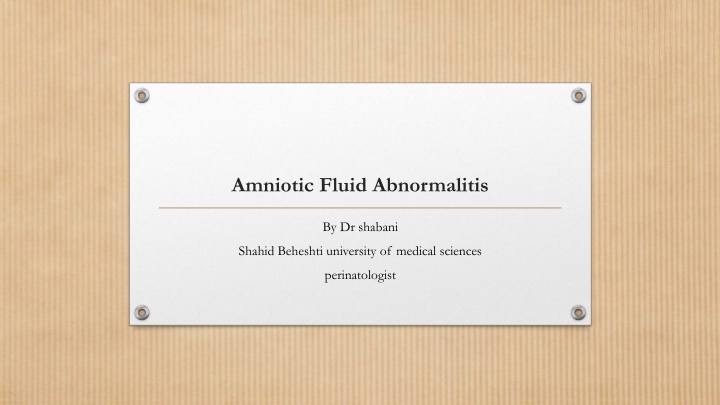
Amniotic Fluid Abnormalities in Pregnancy
Learn about amniotic fluid and its importance in pregnancy, how abnormalities like oligohydramnios can occur, possible causes such as maternal medical conditions and placental issues, and potential fetal outcomes. Early detection and management are crucial for ensuring a healthy pregnancy.
Download Presentation

Please find below an Image/Link to download the presentation.
The content on the website is provided AS IS for your information and personal use only. It may not be sold, licensed, or shared on other websites without obtaining consent from the author. If you encounter any issues during the download, it is possible that the publisher has removed the file from their server.
You are allowed to download the files provided on this website for personal or commercial use, subject to the condition that they are used lawfully. All files are the property of their respective owners.
The content on the website is provided AS IS for your information and personal use only. It may not be sold, licensed, or shared on other websites without obtaining consent from the author.
E N D
Presentation Transcript
Amniotic Fluid Abnormalitis By Dr shabani Shahid Beheshti university of medical sciences perinatologist
INTRODUCTION AF is the liquid that surrounds the fetus after the first few weeks of gestation It helps to protect the fetus from trauma to the maternal abdomen It cushions the umbilical cord from compression between the fetus and uterus It has antibacterial properties that provide some protection from infection It serves as a reservoir of fluid and nutrients for the fetus
WHEN TO ASSESS AF Qualitative or semiquantitative assessment of AF is a standard component of every second- and third-trimester ultrasound examination, regardless of indication Because it is an indicator of fetal health Its assessment is useful for evaluation of pregnancies at risk for an adverse pregnancy outcome
Oligohydramnios Oligohydramnios refers to AFV that is less than the min expected for GA It is diagnosed by ultrasound examination, preferably based on an objective measurement AFI 5 cm or SDP <2 cm but a subjective assessment of reduced AFV is also acceptable
ETIOLOGY Maternal Medical or obstetric conditions associated with uteroplacental insufficiency: preeclampsia, chronic hypertension, collagen vascular disease, nephropathy, thrombophilia Medications :angiotensin converting enzyme inhibitors, NSAIDs, trastuzumab Diabetes insipidus (rare cases have presented with oligohydramnios that improve upon maternal treatment with desmopressin)
Placental Abruption Twin to twin transfusion (ie, twin polyhydramnios-oligohydramnios sequence) Placental thrombosis or infarction
Fetal Chromosomal abnormalities Congenital abnormalities, especially those associated with impaired urine production or excretion Growth restriction Demise Postterm pregnancy Ruptured fetal membranes Infection Idiopathic
fetal prognosis Fetal prognosis depends on several factors: particularly underlying cause, severity (reduced versus no amniotic fluid), GA Because an adequate AF is critical to normal fetal movement and second-trimester lung development and for cushioning the fetus and umbilical cord from uterine compression Oligohydramnios from any cause are at risk for pulmonary hypoplasia (if second- trimester oligohydramnios), fetal deformation (if prolonged oligohydramnios), and umbilical cord compression. Increased risk for fetal or neonatal death: related to the underlying cause of the reduced AF, the sequalae of reduced AF, or both
Second trimester By the beginning of the second trimester, fetal urine is being produced and entering the amniotic sac. Therefore, congenital anomalies related to the fetal kidney and urinary tract Maternal and placental factors, as well as ROM (traumatic or spontaneous), are also common causes of oligohydramnios in 2 trimester Fetal anomaly ,PPROM,Placental abruption , FGR, Idiopathic The pregnancy outcome : generally poor due to fetal or neonatal death or pregnancy termination
Third trimester Other causes: uteroplacental insufficiency (FGR, preeclampsia, and/or chronic abruption) & fetal anomalies In addition, many cases are idiopathic Fetal TORCH (toxoplasma gondii, rubella virus, cytomegalovirus, herpes simplex virus) and parvovirus B19 infections are uncommon but may be associated with second- or third-trimester oligohydramnios Oligohydramnios first diagnosed in the third trimester is often PPROM Oligohydramnios is more prevalent in postterm pregnancies since AF normally begins to decline late in the third trimester
MANAGEMENT Patients with newly diagnosed oligo early in 3 trimester undergo evaluation of possible causes and daily NSTs until fetal status is clarified Patients with anhydramnios are hospitalized for both diagnostic evaluation & fetal surveillances Maternal and FH and a targeted Ph.E to look for maternal and familial conditions that may be associated with oligo Maternal medications that cause oligo affect fetal urination and do not cause FGR, whereas maternal medical disorders often result in uteroplacental insufficiency, leading to both FGR and oligo Rule out PROM
Ultrasound Assessment for fetal anomalies particularly assessment of : Kidneys & Bladder Umbilical cord fetal insertion site and vessel number Fetal sex (males are prone to renal dysplasia and agenesis, PUV) Second-trimester markers suggestive of aneuploidy FGR Placental abnormalities (eg, chronic abruption) Doppler : There is no clear role for Doppler imaging in the evaluation of fetuses with kidneys and isolated oligohydramnios presence of renal arteries when the kidneys are not well visualized
Genetic testing If fetal anomalies are identified, offering fetal diagnostic genetic testing (amniocentesis for microarray on amniocytes) is routine. For patients who decline amniocentesis, we offer a noninvasive screening test (cell-free DNA)
Diagnostic maternal hydration Oral hydration with one to two liters of water may be an alternative to amnioinfusion to transiently increase AFV for up to 48 hours, particularly in hypovolemic patients. This approach is easier and safer than intravenous (IV) fluid administration or amnioinfusion maternal hydration was most effective in pregnancies with isolated oligohydramnios
Laboratory testing No routine testing is required. Testing maternal serum or AF for an infection-related etiology (maternal TORCH [toxoplasma gondii, rubella virus, cytomegalovirus, herpes simplex virus] and parvovirus 19 infection) depends on the degree of suspicion (eg, suggestive maternal Hx and symptoms, other fetal abnormalities on ultrasound)
Oligohydramnios after amniocentesis An exception to the poor prognosis described above is oligohydramnios related to second-trimester amniocentesis. In these cases, the membranes often "reseal," amniotic fluid reaccumulates, and pregnancy outcome is normal
Timing of delivery Oligohydramnios of known etiology : The indications for delivery in pregnancies with oligohydramnios attributable to a specific condition : preeclampsia, PROM, FGR, congenital anomaly, postterm pregnancy Idiopathic oligohydramnios (ACOG): In pregnancies with idiopathic oligo and reassuring fetal testing we suggest delivery at 36 to 37+6 w If diagnosed later If diagnosed later : at Dx
Intrapartum fetal monitoring In patients with oligohydramnios, we recommend using continuous electronic fetal monitoring, given the increased risk for cord compression. However, most patients will have a normal tracing
Polyhydramnios also known as hydramnios: refers to an excessive volume of AF It should be suspected clinically when uterine size is large for gestational age (fundal height [cm] : exceeds weeks of gestation by >3) Dx: sonographic documentation of excessive AFV by a quantitative technique :AFI 24 cm or single deepest pocket (SDP) 8 cm
Conditions associated with polyhydramnios Genetic syndromes: Trisomy 18 or 21,Prader-Willi,Bartter,Beckwith-WiedemannRASopathy (eg, Noonan syndrome, cardiofaciocutaneous syndrome, Costello syndrome, capillary malformation-arteriovenous malformation, and neurofibromatosis type 1) Fetal neuromuscular disorder that impedes swallowing (eg, myotonic dystrophy, anencephaly)
Conditions associated with polyhydramnios Fetal anomalies : Fetal anomalies account for approximately one-third of singleton pregnancies with polyhydramnios The most common anomalies interfere with fetal swallowing and/or absorption of fluid Fetal structural anomaly that impedes swallowing: Primary gastrointestinal obstruction (eg, esophageal or duodenal atresia) Secondary gastrointestinal obstruction (eg, congenital diaphragmatic hernia, cervical or thoracic mass) Craniofacial abnormality (eg, cleft lip/palate, facial tumor [eg, oropharyngeal teratoma], micrognathia)
Conditions associated with polyhydramnios High fetal cardiac output state: Supraventricular tachycardia Severe anemia (eg, alloimmunization, viral infection [Parvovirus B19, cytomegalovirus], hemoglobinopathy) Fetal or placental mass with arteriovenous shunt (eg, sacrococcygeal teratoma, large chorioangioma) Twin-twin transfusion syndrome Maternal DM, Macrosomia, Hydrops fetalis Idiopathic cases : Approximately 40 percent of polyhydramnios is idiopathic
Fetal growth restriction : When combined with polyhydramnios, FGR is associated with high morbidity and mortality The combination of fetal growth restriction and polyhydramnios is suggestive of trisomy 18 Neuromuscular disorders : Fetal neuromuscular disorders, such as anencephaly and myotonic dystrophy, are rare and generally cause polyhydramnios by interfering with swallowing
POSTDIAGNOSTIC EVALUATION Detailed medical Hx: to evaluate for heritable diseases associated with polyhydramnios.:arthrogryposis often presents in the second trimester with polyhydramnios and multiple congenital contractures, in ultrasound personal/family history suggests a hereditary anemia (eg, alpha-thalassemia)
Evaluate for fetal hydrops : If polyhydramnios is accompanied by hydrops, :Fetal anemia is a common cause of hydrops and has both immune and nonimmune etiologies Measure MCA PSV: In the initial evaluation of all cases of idiopathic poly before 35 w, even in the absence of hydrops Evaluate for fetal anomalies :A detailed sonographic evaluation for fetal anomalies Offer genetic counseling and fetal genetic studies: genetic counseling and offering amniocentesis for fetal microarray in pregnancies with a congenital anomaly or severe polyhydramnios Screen for maternal diabetes
OUTCOME Many idiopathic cases resolve spontaneously, especially if mild. Transient cases generally have a benign maternal course, but associated with an increased risk for macrosomia Maternal respiratory compromise PROM Preterm labor and birth Fetal malposition Macrosomia (potentially leading to shoulder dystocia) Umbilical cord prolapse Abruption (particularly upon membrane rupture) Longer second stage of labor Postpartum uterine atony
Management Idiopathic polyhydramnios : Depends upon the GA, severity, and presence of symptoms Mild to moderate poly:BPP, NST every 1 to 2 w until 37 w, and then weekly from 37 w to birth severe : BPPs (including NST) every week from Dx until birth In interpreting the BPP score, clinicians should be cautious about conclusions of fetal well-being with a borderline score (6/8) since the two points for amniotic fluid volume (AFV) in these cases are not reassuring
MANAGEMENT Amnioreduction :severe shortness of breath or abdominal discomfort and uterine contractions, we give a short course (48 h) of indomethacin Indomethacin : SMFM recommends not indomethacin for the sole indication of reducing amniotic fluid In pregnancies <32 w with preterm labor/uterine irritability, we sometimes use a short course (48 h) of indomethacin for its combined effects of tocolysis and reduction in AF
Timing of delivery Mild to moderate poly : In patients with mild to moderate idiopathic polyhydramnios and normal BPPs Induce labor at 39 to 40 as the risk of fetal death appears to increase significantly at term
Timing of delivery Severe idiopathic poly: Induction of labor at 37 w to minimize the risk of umbilical cord prolapse and/or abruption in spontaneous PROM Earlier delivery on a case-by-case basis to patients between 34 and 37 w if symptoms are intolerable and not respond to amnioreduction Delivery at tertiary center in severe idiopathic poly since clinically important fetal abnormalities may not identified prenatally



